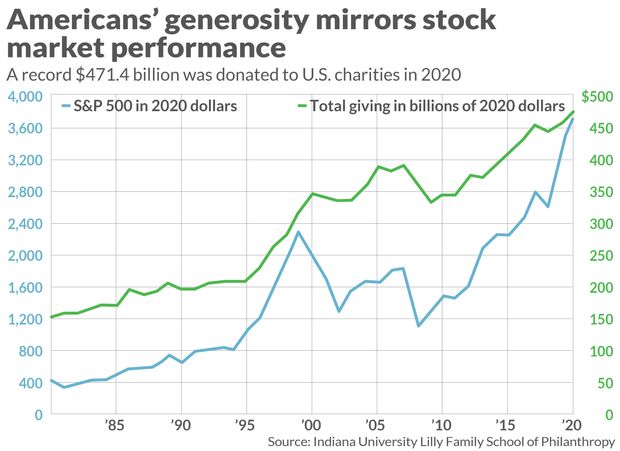U.S. charities took in an estimated $471 billion in donations last year. But that record amount of charitable giving was fueled by more than people’s desire to ease others’ suffering: Americans also opened their wallets to donate because of the stock market’s rebound in the second half of the year.
That’s according to Giving USA 2021: The Annual Report on Philanthropy for the Year 2020, released Tuesday. The report is a publication of the Giving USA Foundation and is researched and written by the Indiana University Lilly Family School of Philanthropy.
Charitable giving in the U.S. hit an all-time high in 2020. Donations from all sources, including individuals, private foundations and corporations, increased an estimated 5.1% from 2019; adjusted for inflation, the increase was 3.8%.
“There was extraordinary generosity, but also unprecedented need,” said Una Osili, associate dean for research and international programs at the Lilly Family School of Philanthropy. “We have to put those two factors side by side.”
“ Acute suffering from COVID-19, the pandemic-related recession and a national reawakening over racial injustice happened alongside a stock-market turnaround. ”
While many households were hit hard by the pandemic and its related economic downturn, others weathered the financial storm and are now emerging better off than ever, Osili noted.
“Some Americans were not just in a position to give, but even had more resources to give — disposable income, higher savings, they weren’t spending as much — and there were so many opportunities to give,” Osili told MarketWatch.
A look at what fueled those donations is a reminder of 2020’s sharp contrasts. Acute suffering from COVID-19, the pandemic-related recession and a national reawakening over racial injustice happened alongside a stock-market turnaround. The Dow Jones Industrial Average DJIA, -0.12% and S&P 500 Index SPX, -0.02% hit rock-bottom lows in the early spring as the pandemic spurred a global recession, but ended the year with strong gains.
While high net worth households are more directly affected by stock appreciation, Osili said, “markets tend to provide a sense of financial and economic security and households tend to give, at all income levels, when they feel financially and economically secure.”
The market rally in the second half of the year happened at a time when many people typically make their charitable contributions. Meanwhile, government stimulus programs put cash in Americans’ pockets.
“By the end of 2020, the S&P 500, which is closely related to giving, grew 16.3%, and personal income, a factor that is significantly linked to individual giving, grew 6.1%,” the report authors noted.
As income inequality has deepened and the wealthiest have seen their fortunes grow, philanthropy has been increasingly dominated by mega-donors who give away millions at a time. Meanwhile, the share of U.S. households that donate to charity has fallen over the past two decades. A 2020 Gallup poll showed a decline in the share of lower and middle-income households who were giving to charity last year.
Americans’ generosity is traditionally fueled by stock-market performance
To be sure, altruism plays a role in why people donate money to nonprofits such as food banks and other human-service organizations. But it’s also true that individuals’ charitable giving in the U.S. traditionally tracks with stock-market performance.
“Large individual donors like to solve really big problems and we had really big problems to solve in 2020,” said Joshua Birkholz, vice-chair of the Giving USA Foundation and CEO of the fundraising firm Bentz Whaley Flessner. “We had a combination of market performance plus some really big issues around the pandemic and the growing awareness of racial inequality, which were a perfect mix where philanthropy could do something really impactful, and donors stepped up.”

Where people donated
- Giving to human service organizations, such as hunger-relief groups and others that provide basic needs, increased by an estimated 9.7% in 2020, totaling $65 billion.
- Giving to education increased by an estimated 9% to $71 billion, fueled in part by MacKenzie Scott, the former wife of Amazon AMZN, +0.60% founder Jeff Bezos, who gave out nearly $6 billion in 2020 and concentrated much of her giving on historically Black colleges and universities, tribal colleges, Hispanic-serving schools and community colleges.
- Giving to arts and culture groups fell by an estimated 7.5% to $19 billion.
Corporate giving fell
On the flip side, philanthropic giving by corporations declined by about 6.1% in 2020 to an estimated $16.88 billion, according to the Giving USA report. That may sound surprising, given the many companies that made big-money pledges last year to address both the pandemic and racial justice issues.
“It’s not as surprising when you look at the fact that corporate profits declined year-end,” Osili said.
Corporate giving is “highly responsive to changes in corporate pre-tax profits and GDP, both of which declined in 2020,” the report authors said.







